As one of the country’s largest agricultural states and extended stretches of lands and forests, North Dakota’s rich wildlife is not a surprise to anyone.
In fact, according to the North Dakota Game and Fish Department (NDGF), the North Dakota Bird Records Committee (NDBR), and other Birding Checklists, the Peace Garden State is home to anywhere between 375 to 415 documented species of birds!
If you want to know more about the birds in North Dakota, you’re in for a treat! In today’s article, we’ll walk you through a brief guide to some of the most impressive and colorful birds in the state.
So without further ado, let’s dive in!
Red Birds in North Dakota
Downy Woodpecker

- Scientific Name: Dryobates pubescens
- Length: 5.5 to 7.1 In
- Weight: 0.7 to 1.1 oz
- Wingspan: 9.8 to 12.2 In
The Downy Woodpecker is one of the most common woodpeckers in the state, and they’re known for the red patch above the head as well as the red and white plumage across their bodies.
The bird usually feeds on anything from food remains to seeds and nuts, and since they’re well adapted to residential areas, you’ll typically find them hanging around your backyard and even nesting in bird boxes.
Red-Winged Blackbird
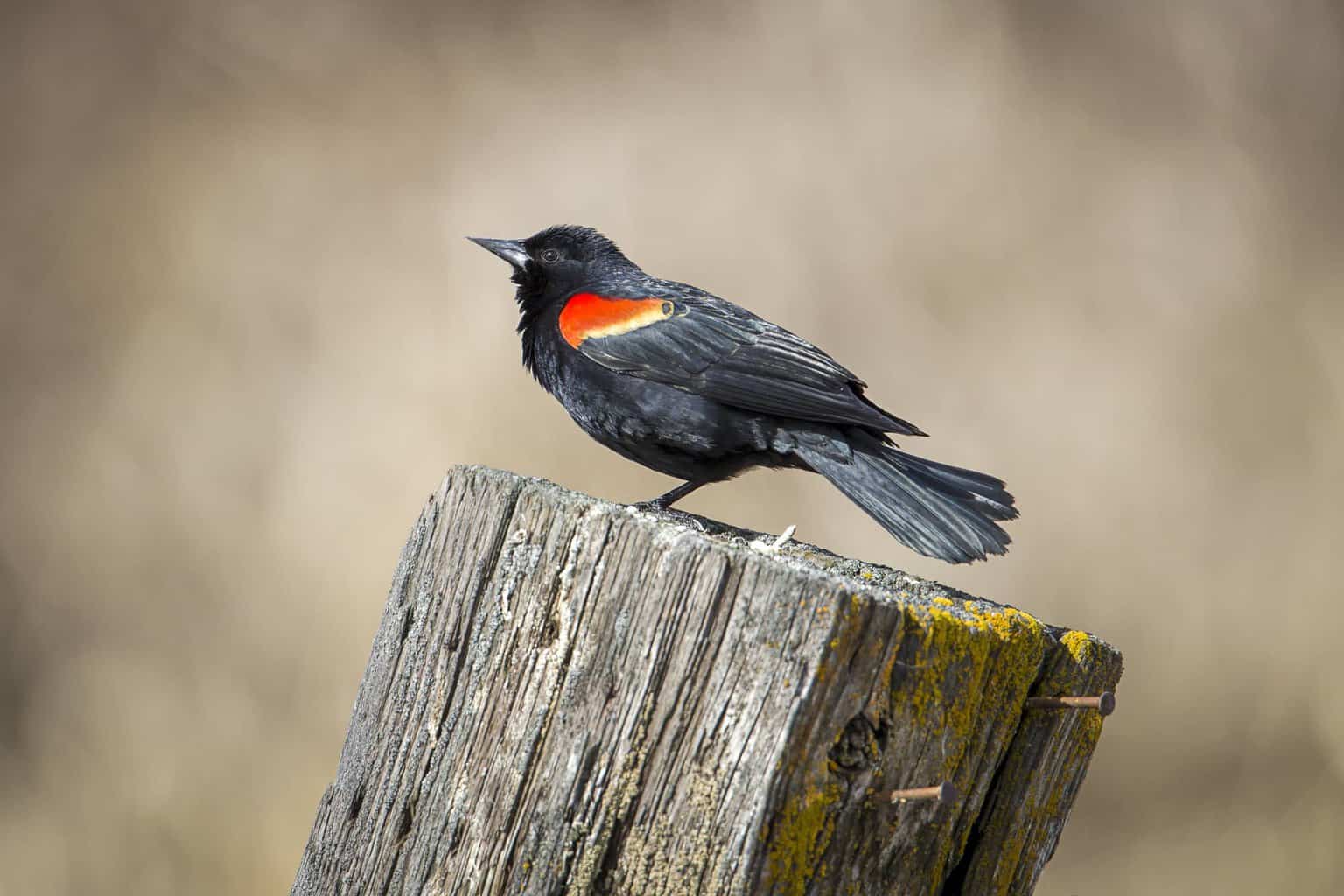
- Scientific name: Agelaius phoeniceus
- Length: 6.7 to 9.1 in
- Weight: 1.1 to 2.7 oz
- Wingspan: 12.2 to 15.8 in
The Red-winged Blackbird is one of the most common types of blackbird in all of North Dakota and neighboring states.
Unlike a common blackbird, which rocks an all-black appearance, this one incorporates a colorful plumage of red and yellow at the shoulder and extends through the first 1/3 of the wing.
However, you should keep in mind that this look is mainly exclusive to males. Females, on the other hand, have mostly brown plumage all over their bodies with some heavy streaking that covers their backs and underparts.
The unique color pattern makes the bird easy to spot, especially if you look for them around bodies of water, such as wetlands, marshes, lakes, rivers, and streams.
Hairy Woodpecker
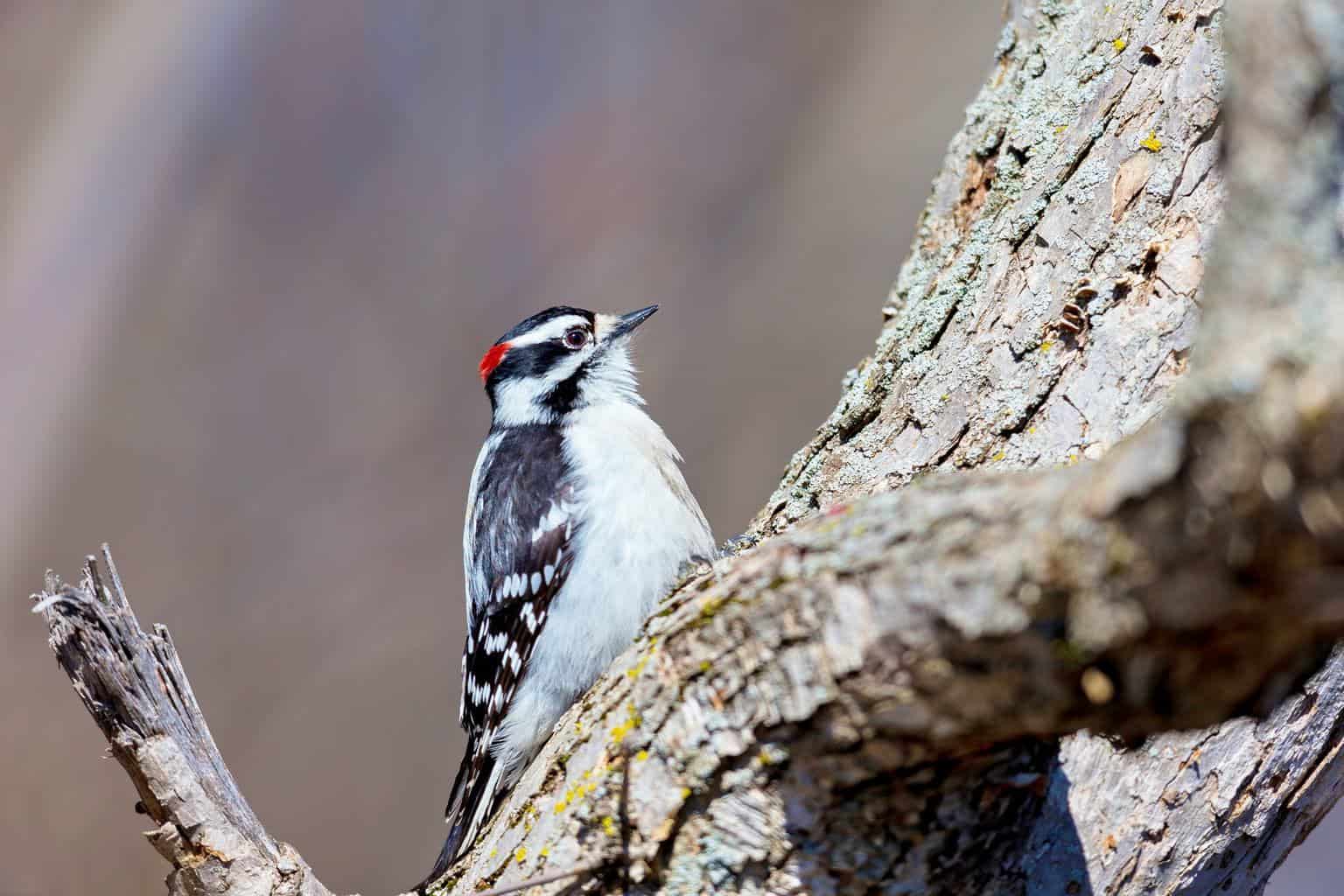
- Scientific Name: Dryobates villosus
- Length: 7.1 to 10.2 in
- Weight: 1.4 to 3.4 oz
- Wingspan: 13.0 to 17.0 in
The Hairy Woodpecker is quite similar to the Downy Woodpecker and also common in North Dakota. However, it’s quite big with a relatively large bill compared to its size.
This bird is also attracted to the same kind of food as the Downy Woodpeckers, so the size is the best way to tell them apart when they’re hovering around your bird feeder.
Blue Birds in North Dakota
Eastern Bluebird

- Scientific Name: Sialia sialis
- Length: 6.3 to 8.3 In
- Weight: 0.9 to 1.2 oz
- Wingspan: 9.8 to 12.6 In
The Eastern Bluebird is also a pretty common bird in North Dakota. Similar to the Western Bluebird, this one has a vibrant blue color that covers the head, wing, back, and tail of the bird.
However, you can easily distinguish the Eastern Bluebird thanks to its reddish-brown plumage that covers the bird’s throat and underparts.
Blue Jay

- Scientific Name: Cyanocitta cristata
- Length: 8.6 to 11.8 in
- Weight: 2.5 to 3.5 oz
- Wingspan: 13.3 to 16.9 in
Blue Jays are one of the most popular birds in North America. Despite being extremely loud to the point of being annoying to many people, a lot of bird watchers love the bird due to its amazing color patterns.
Blue Jays have an astonishing cyan color of different shades that cover their entire body. However, the color is due to their feather structure, as the bird doesn’t have any blue pigments.
The bird is also quite smart and can imitate the sound of hawks to scare off other birds or warn them about approaching predators.
Additionally, the bird is among the few birds that are capable of cracking a nut open.
Common Grackle
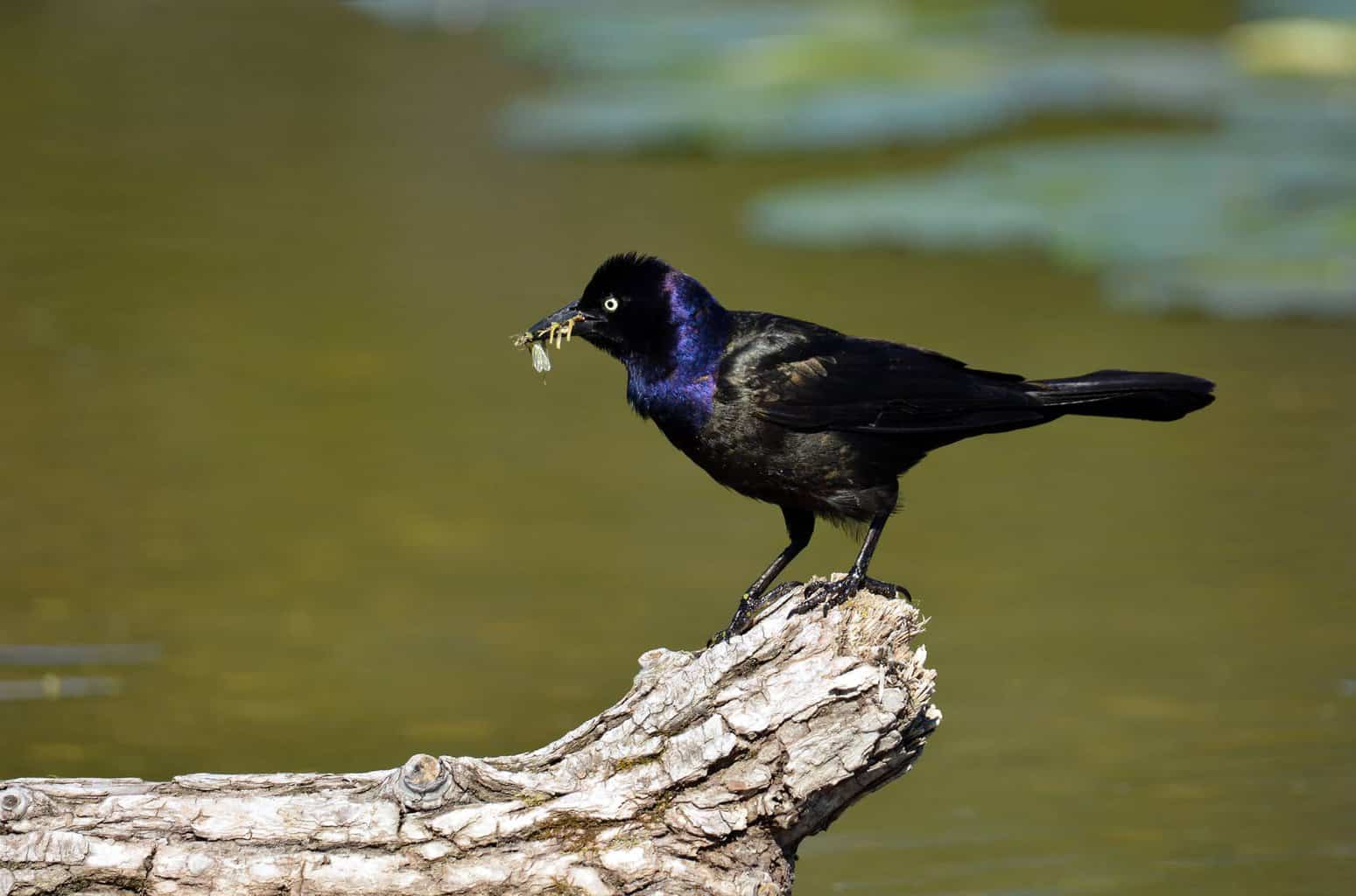
- Scientific name: Quiscalus quiscula
- Length: 11.0 to 13.4 in
- Weight: 2.6 to 5.0 oz
- Wingspan: 14.2 to 18.1 in
The Common Grackle is another blue and black-colored bird belonging to the family of blackbirds in the state.
The bird likes to live in large flocks where they make remarkable noises that make them easy to spot. Common Grackles have blue heads with an iridescent brown body that shines in hues of purple.
Barn Swallow
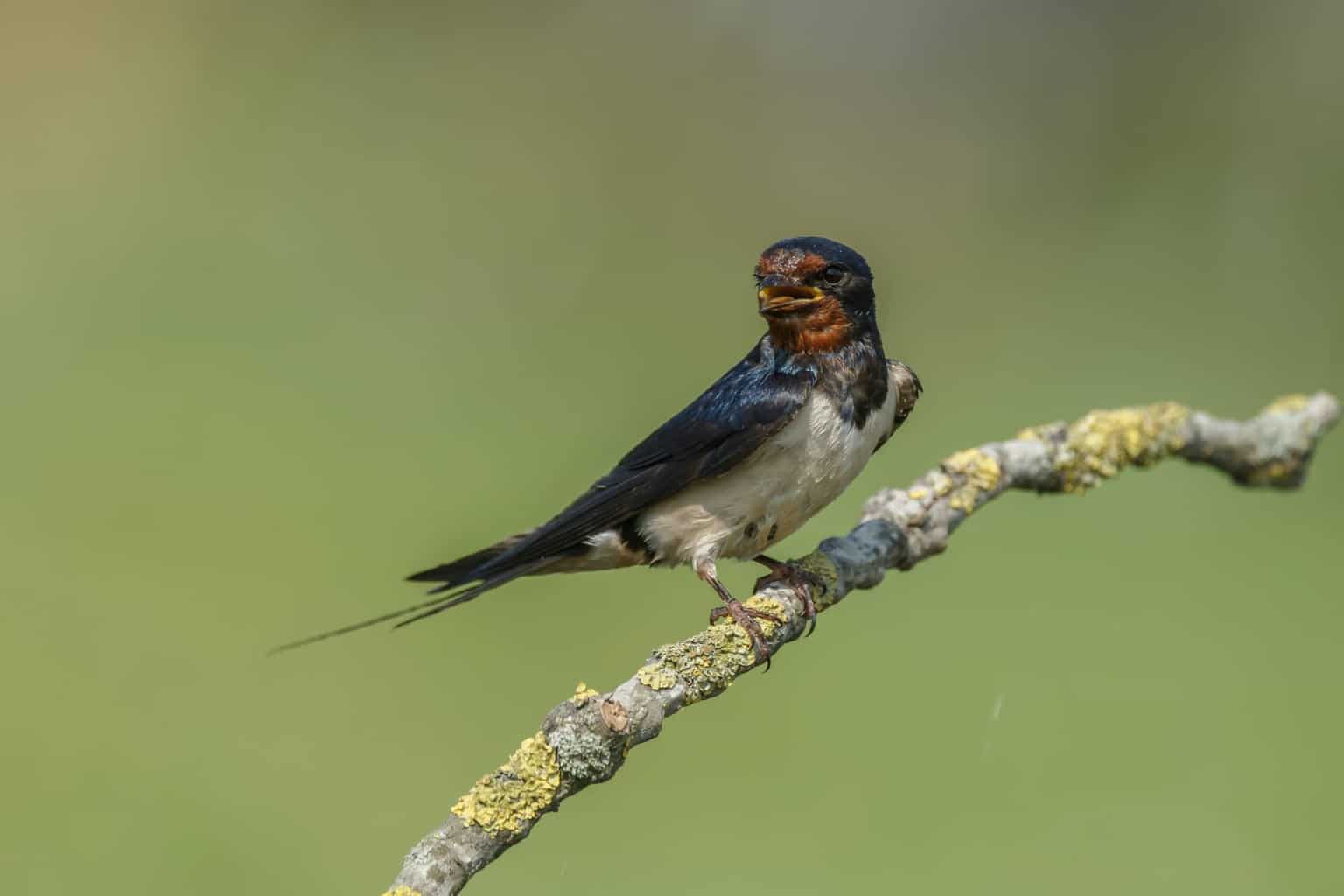
- Scientific Name: Hirundo rustica
- Length: 6.7 to 7.5 inches
- Weight: 0.56 to 0.78 ounces
- Wingspan: 12.6 to 13.6 inches
The Barn Swallow is the most common species of swallow in all of North America, so these birds are fairly common in North Dakota as well.
Like other swallows, they prefer living in large groups, and you can easily find them in meadows and large open fields where they can feed on various types of insects. The birds have steely blue feathers that cover most of their upper body.
Green Birds in North Dakota
Ruby-Throated Hummingbird
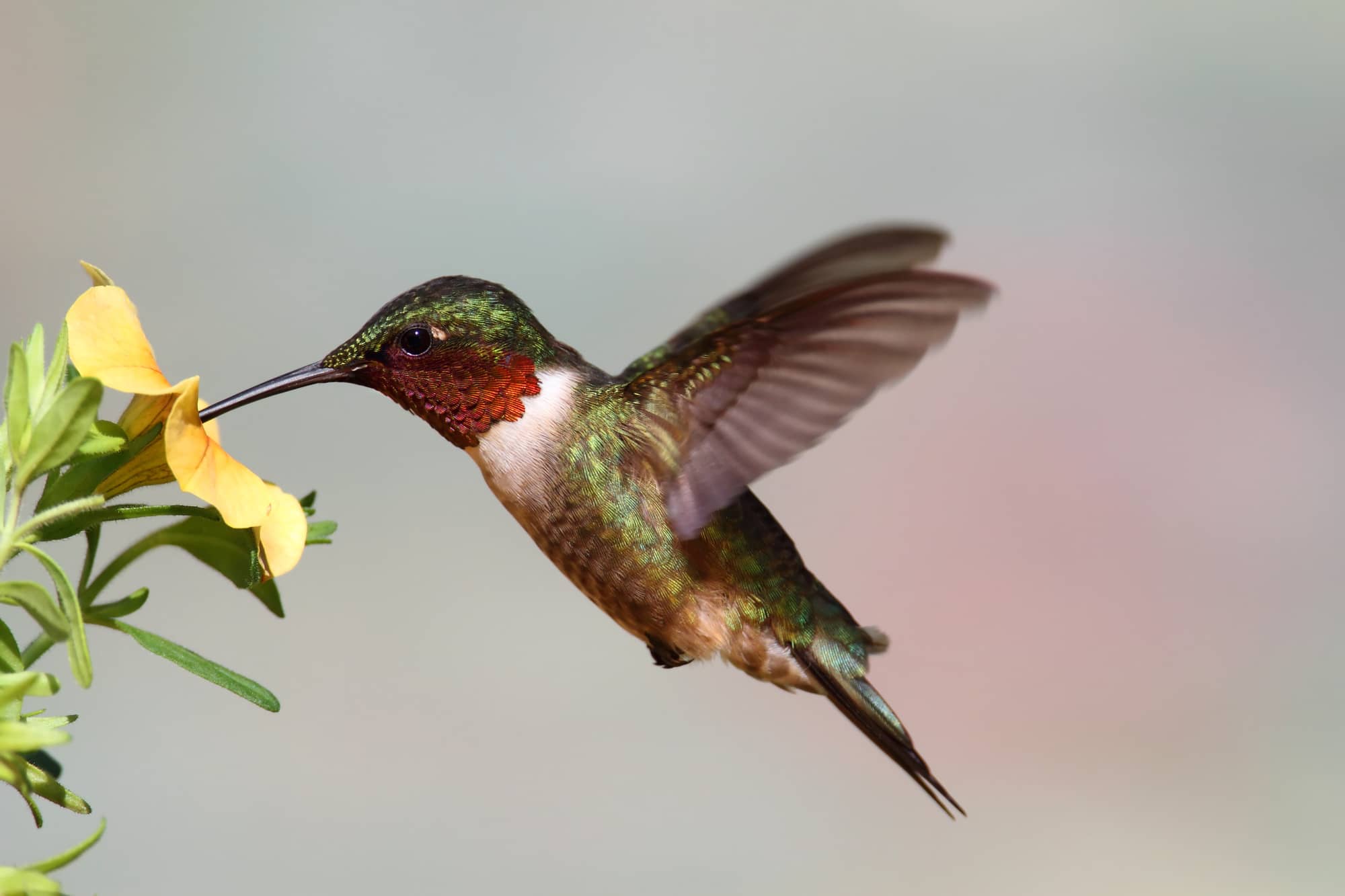
- Scientific Name: Archilochus colubris
- Length: 2.8 to 3.5 in
- Weight: 0.1 to 0.2 oz
- Wingspan: 3.1 to 4.3 in
Similar to most northern states in the U.S.A, North Dakota’s hummingbird population is mostly composed of a single species, which is the Ruby-throated Hummingbird.
This one has an iridescent ruby-red plumage around the throat along with a bright green back and a white belly with a green wash.
Violet-Green Swallow
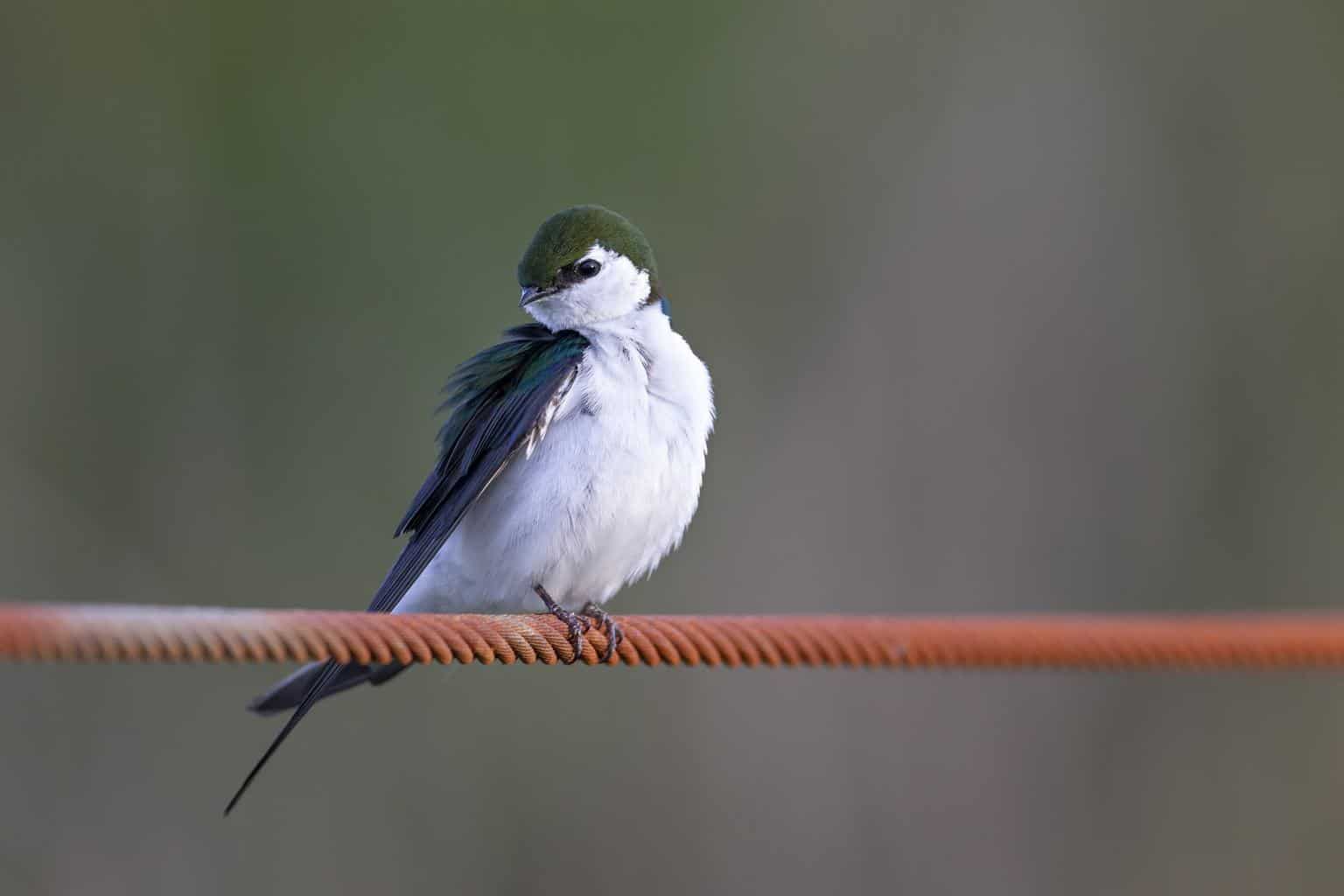
- Scientific name: Tachycineta thalassina
- Length: 4.5 to 5.0 in
- Weight: 0.4 to 0.6 oz
- Wingspan: 10.1 to 11.0 in
Another swallow that is quite common in North Dakota is the Violet-green Swallow. As you might’ve expected from the bird’s name, it features some of the most impressive color patterns among all birds in the state.
The birds usually live in large groups, which makes them easy to identify, especially if you look for them around large trees and high telephone wires. They also fly around bodies of water looking for flying insects, their favorite meal.
The bird has dark velvety green plumage over its back which extends to the top of its head, along with violet feathers at the rump area.
Orange Birds in North Dakota
American Robin

- Scientific Name: Turdus migratorius
- Length: 9.0 to 11.0 In
- Weight: 2.3 to 2.8 oz
- Wingspan: 14.7 to 16.5 In
The American Robin is one of the most common backyard birds in North Dakota, if not the most common year-round bird out there.
The bird is also found in wild forests and you’ll be able to distinguish them due to the reddish-orange plumage that covers their breast and underparts with black plumage covering the rest of their body.
The bird is well adapted to residential areas and can be pretty friendly around humans. They’re also known for laying beautiful sky-blue eggs in small nests.
Baltimore Oriole
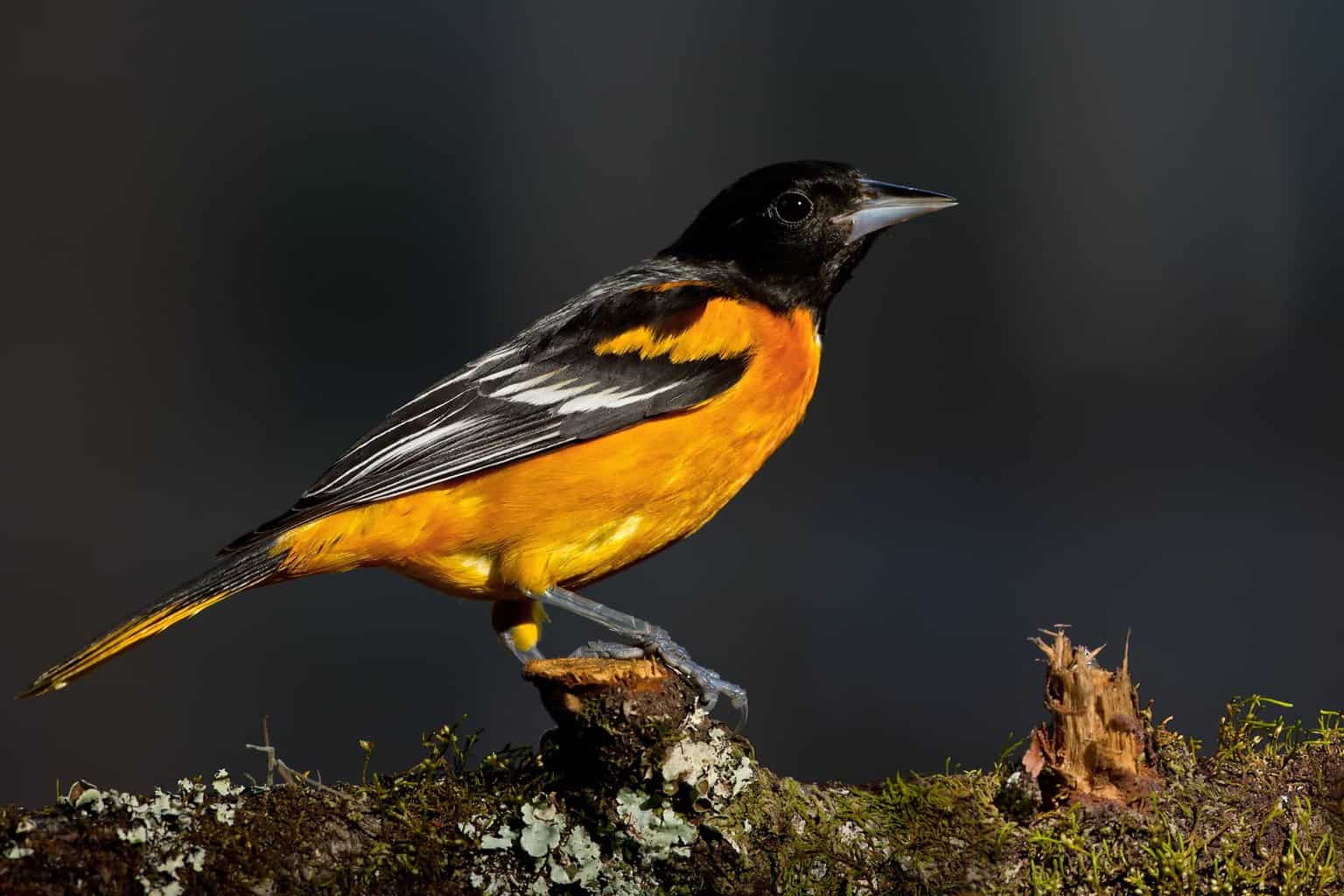
- Scientific Name: Icterus galbula
- Length: 5.8 to 7.8 in
- Weight: 2.3 to 3.5 oz
- Wingspan: 3.5 to 4.7 in
The Baltimore Oriole is one of the most appealing birds that you can find hovering around your backyard bird feeder.
The bird is named after the color of the coat of arms of Lord Baltimore, which had the same flaming orange color that makes the Baltimore Oriole special.
The color covers most of the underparts of the bird as well as the rump and shoulders in males, with paler but similar patterns in juveniles and females.
Varied Thrush
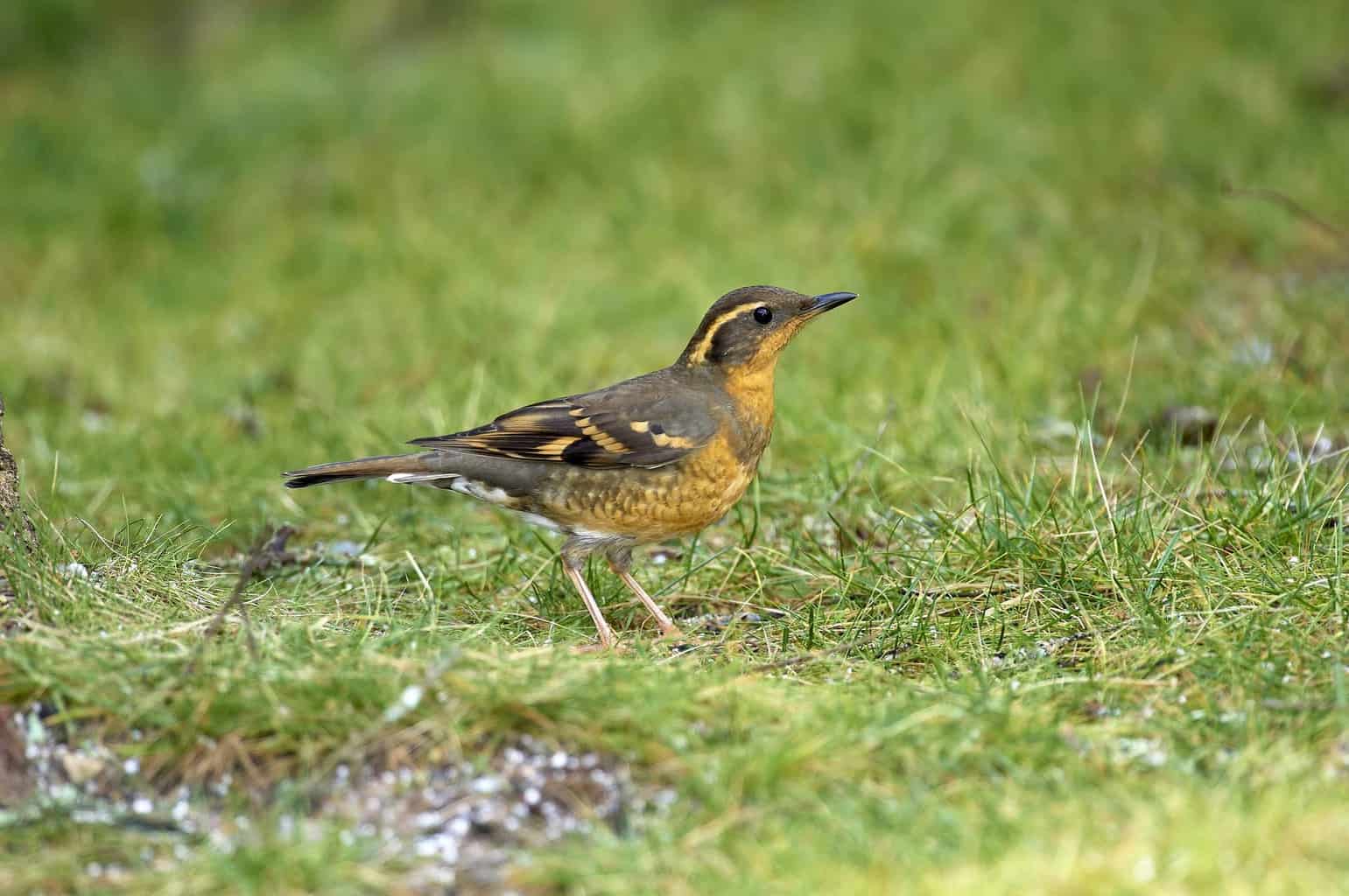
- Scientific Name: Ixoreus naevius
- Length: 7.5 to 0.2 In
- Weight: 2.3 to 3.5 oz
- Wingspan: 13.1 to 15.3 In
The Varied Thrush is one of the impressive types of birds that are found in a few states, including North Dakota. Although the birds look fairly similar to American Robins, they’re a little smaller with a bluish-gray and a bright orange belly.
Another characteristic feature of the Varied Thrush is the orange-colored patch above its eyes that extends to its wings
Behavior-wise, the Varied Thrush is also quite different. American Robins have a peaceful temperament while these thrushes are quite aggressive toward other birds and tend to dominate them.
The bird is stockier than the American Robin and sings in an equally beautiful tone, with females of the species having similar color patterns but with paler colors.
Yellow Birds in North Dakota
American Goldfinch

- Scientific Name: Spinus tristis
- Length: 4.3 to 5.5 in
- Weight: 0.39 to 0.71 oz
- Wingspan: 7.5 to 8.7 in
The American Goldfinch is one of the most common backyard birds in North America and they’re quite easy to identify as well. This is because these birds are common residents of backyard feeders and have a characteristic bouncy pattern when flying.
The male bird is easily characterized due to its golden yellow color that covers the bird’s belly, back, and face. The black cap on the top of its head as well as the black wings are also characteristic of the bird.
Females typically have similar patterns. However, they’re significantly less vibrant and lack the patch on the head.
Horned Lark
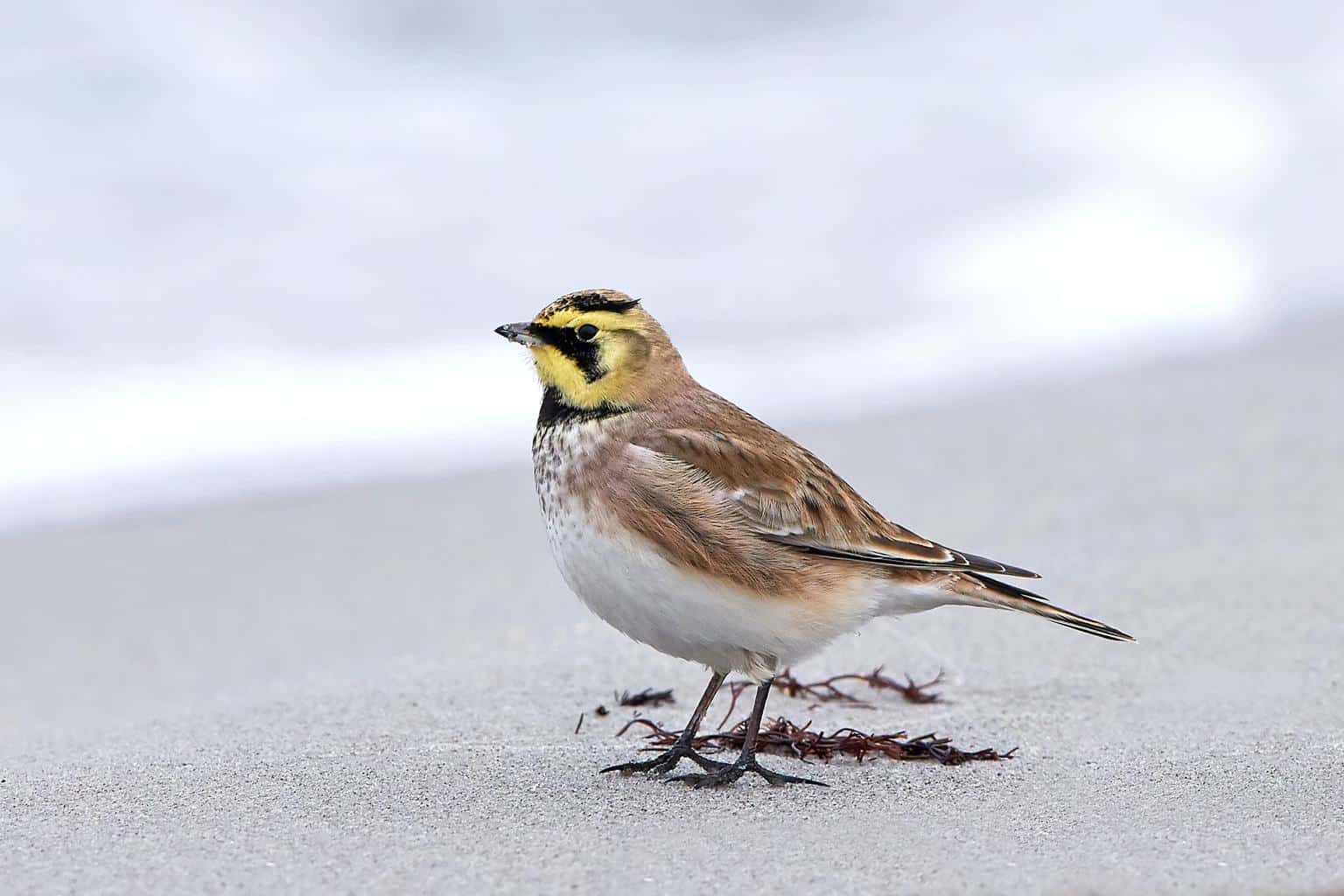
- Scientific Name: Eremophila alpestris
- Length: 6.3 to 7.9 in
- Weight: 1.0 to 1.7 oz
- Wingspan: 11.8 to 13.4 in
The Horned Lark is one of the most unique birds that you can find in the state of North Dakota. The bird has a sparrow-like appearance with a stocky body and a relatively long tail.
The majority of the birds are covered with shades of buff and pale brown plumage. However, the most unique aspect of the bird is the black mask on its face with several patches of yellow on the forehead and throat.
Additionally, the males have a very characteristic horn-like feather that sticks out of their heads, hence the name. Females, on the other hand, will lack both the horns and the yellow coloration.
Western Meadowlark
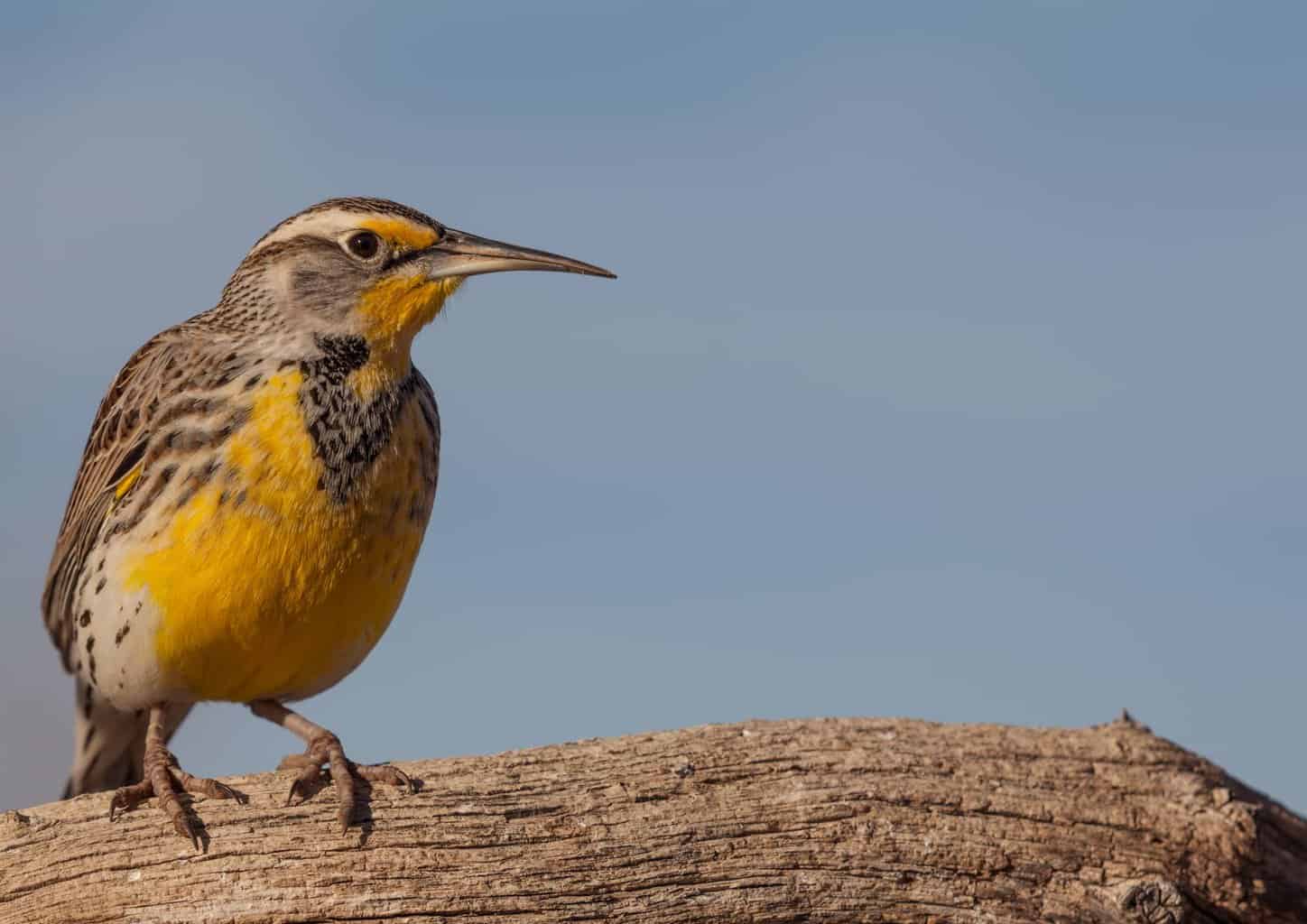
- Scientific Name: Sturnella neglecta
- Length: 6.3 to 10.2 in
- Weight: 3.1 to 4.1 oz
- Wingspan: 16.0 to 16.3 in
The Western Meadowlark is relatively common in North Dakota despite not being a constant species in most other states.
In fact, this popular bird is so loved by the residents that the bird is considered the official bird of North Dakota since 1942.
The bird is a midsized species (the same size as American Robins) that belongs to the family of grassland birds. It has a long and slender bill with a broad-shouldered posture.
Both males and females of this species have a characteristic yellow underpart that extends from the bird’s throat all the way to its belly.
Yellow-Headed Blackbird
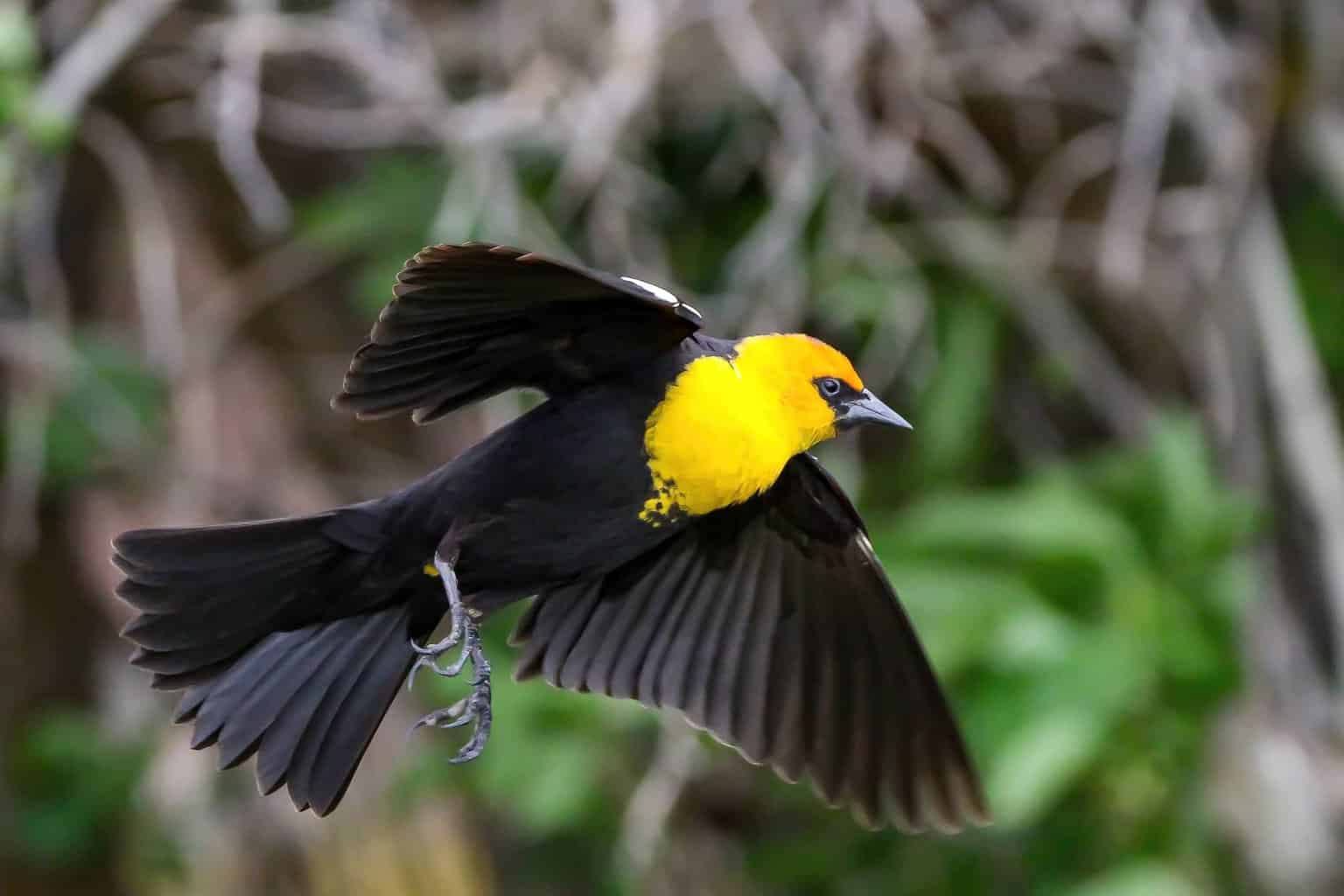
- Scientific Name: Xanthocephalus xanthocephalus
- Length: 8.3 to 10.2 in
- Weight: 1.6 to 3.5 oz
- Wingspan: 16.5 to 17.3 in
In addition to the common and the red-shouldered blackbirds, North Dakota also has another blackbird that is fairly unique and impressive.
The Yellow-headed Blackbird is exactly what the name describes. The bird has standard blackbird body features with most of its body covered in shiny black feathers.
However, the bird’s head is completely covered with yellow-colored feathers that extend all the way from the top of its head to its chest.
Females also have similar features, except that the yellow plumage is limited to the bird’s face and throat.
Similar to other blackbirds, this one lives and breeds around wetlands, rivers, and other bodies of water.
American Yellow Warbler
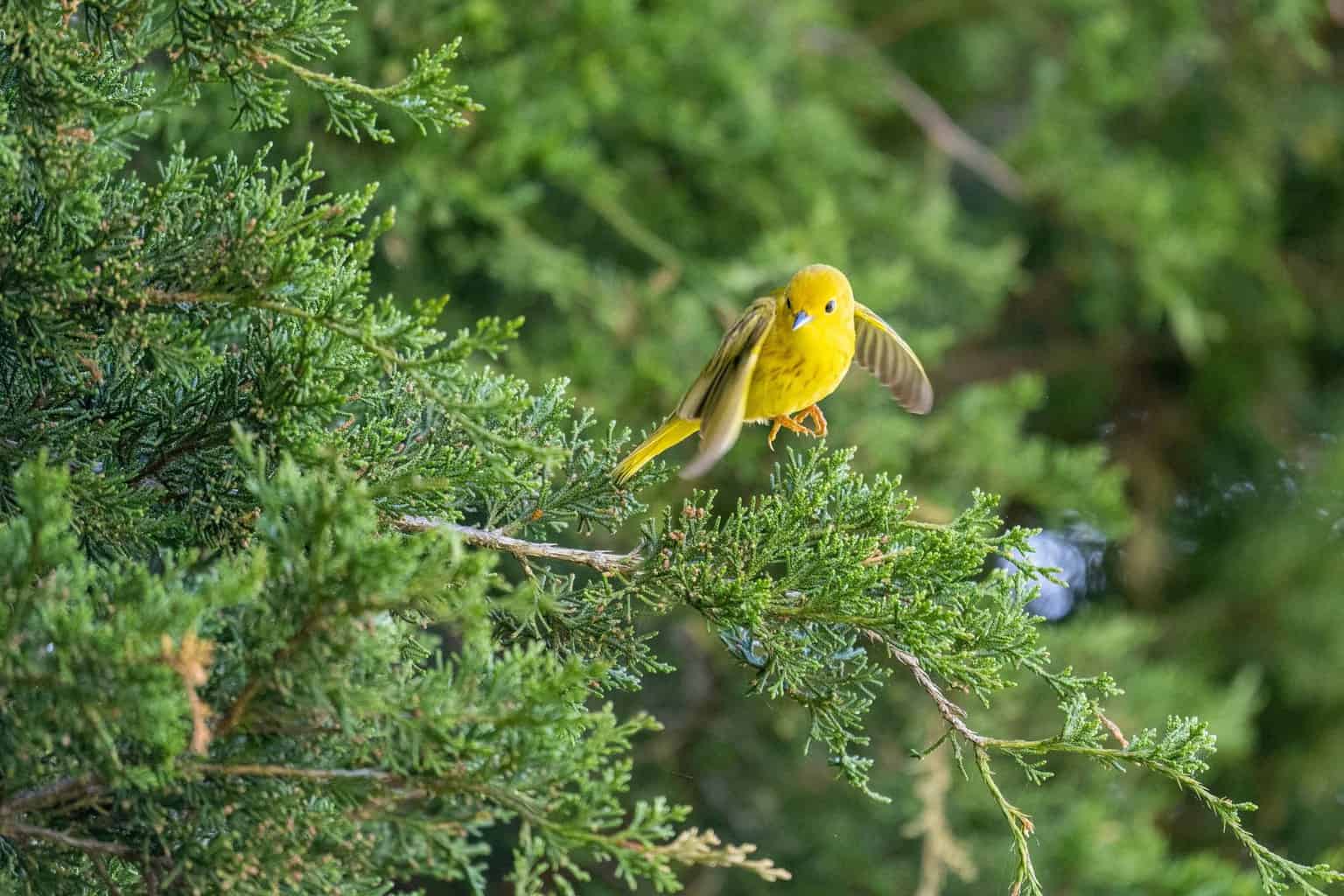
- Scientific Name: Setophaga petechia
- Length: 4.7 to 5.1 in
- Weight: 0.3 to 0.4 oz
- Wingspan: 6.3 to 7.9 in
Adding to the state’s huge variety of yellow birds, we have the American Yellow Warbler, which also rocks a canary yellow plumage that covers the bird’s hood and belly.
This one is a medium-sized warbler that is known for its elusive nature that makes it quite difficult to find in general, despite being fairly common in forests around the state that contain large spruce trees.
The bird has an impressive yellow plumage that extends from the bird’s hood and runs down the bird’s belly. The bird’s back has a green wash.
Other Birds to Watch in North Dakota
Mourning Dove
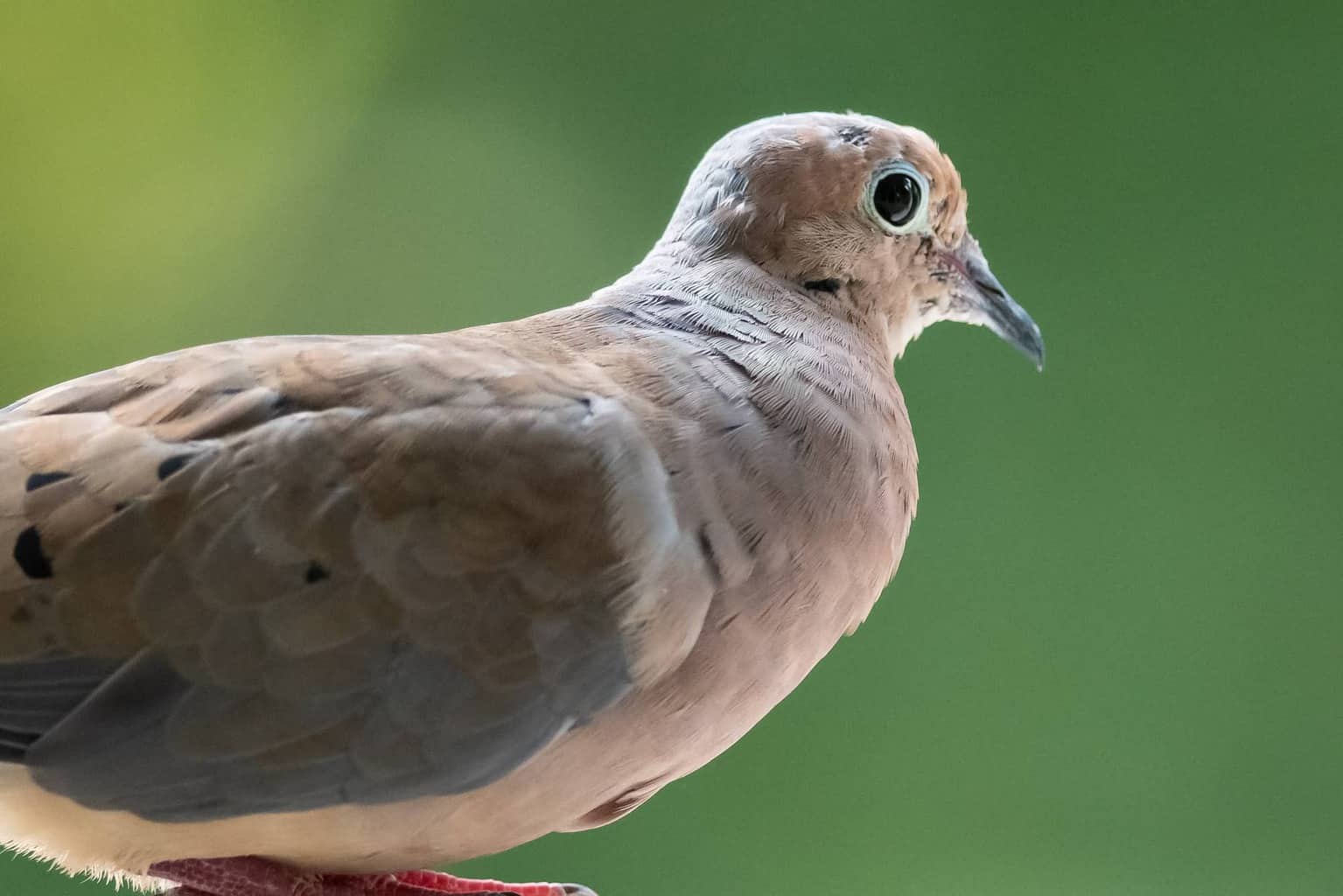
- Scientific Name: Zenaida macroura
- Length: 11.8 to 12.2 inches
- Weight: 4.3 to 6.4 ounces
- Wingspan: 17.3 to 18.2 inches
The Mourning Dove is among the most common types of dove in the state of North Dakota. The bird is characterized by its pale brown to buff-colored body along with various black-colored spots around the bird’s back.
Another feature that makes the Mourning Dove distinguishable from other birds is that they have a pale cyan-colored marking that surrounds the bird’s eyes.
Although the bird is fairly common, they’re difficult to spot on a sandy or rocky background due to their excellent camouflage, but you’ll be able to see them clearly when they land in your backyard while foraging for millet.
European Starling

- Scientific name: Sturnus vulgaris
- Length: 7.9 to 9.1 in
- Weight: 2.1 to 3.4 oz
- Wingspan: 12.2 to 15.8 in
As the name suggests, the European Starling is an invasive species currently found all over North America, despite arriving with European immigrants in the early 1800s.
The bird is known for its mesmerizing iridescent plumage that shines with tints of green and purple when looked at from the right angle.
The bird has a medium-to-large sized body and they’re known for their hostile behavior towards other birds.
Black-Capped Chickadee
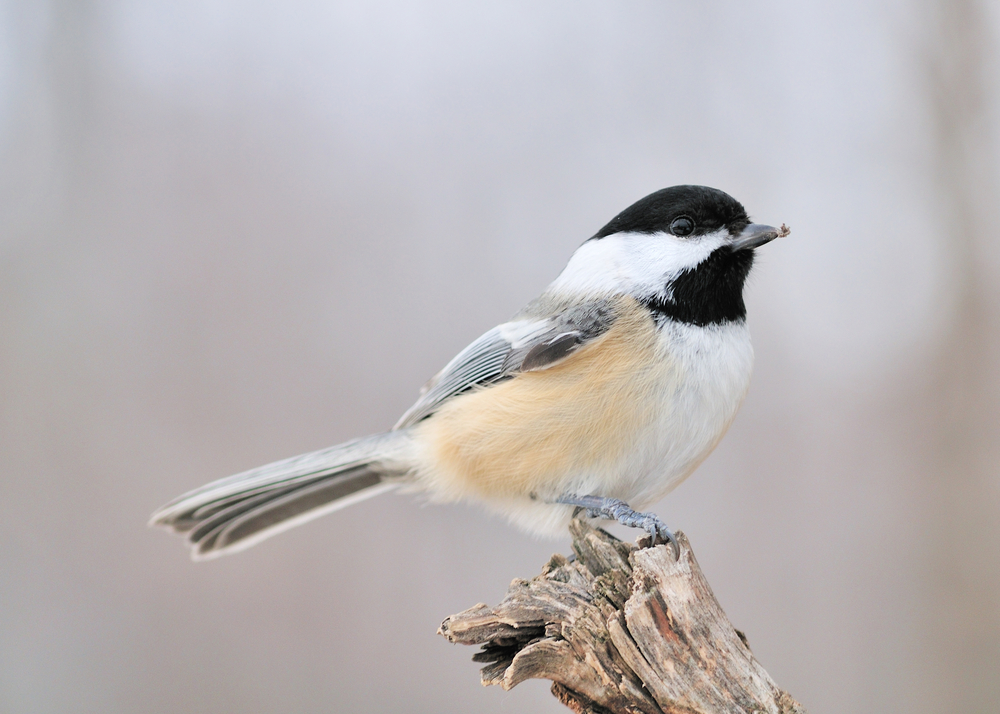
- Scientific name: Poecile atricapillus
- Length: 4.7 to 5.9 in
- Weight: 0.3 to 0.5 oz
- Wingspan: 6.3 to 8.3 in
The Black-capped Chickadee is among the most popular backyard birds in the state of North Dakota.
The bird is known for its relatively big head and extremely short neck, giving it a unique appearance. Another special feature of the bird is the tail, which is relatively thin and long.
Additionally, both the wing and the bird’s cap are colored black while the rest of the Black-capped Chickadee’s body is white, including the wings, the face, and the back.
Brown-headed Cowbirds
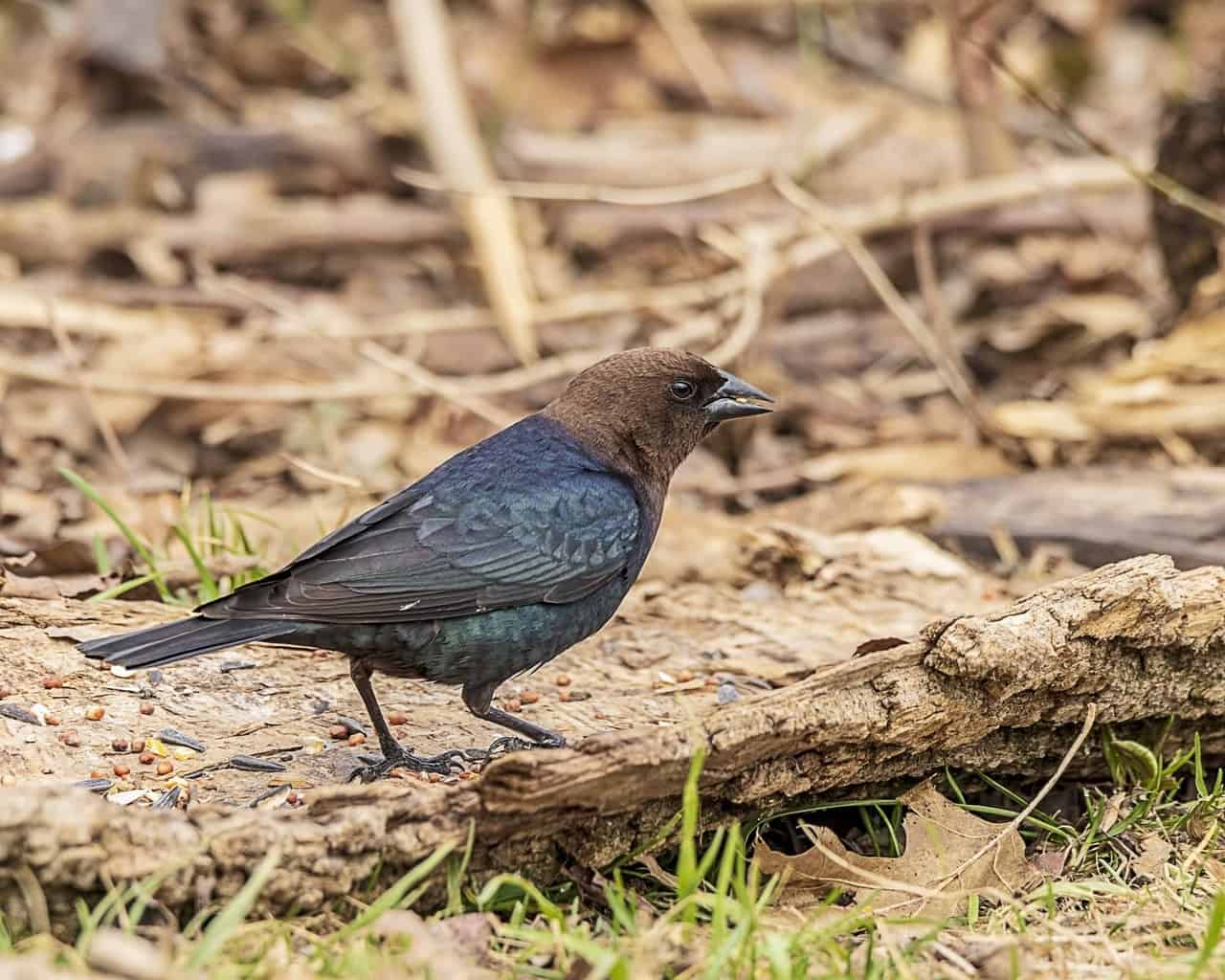
- Scientific Name: Molothrus ater
- Length: 7.5 to 8.7 in (males) – 6.3 to 7.9 in (females)
- Weight: 1.5 to 1.8 oz (males) – 1.3 to 1.6 oz (female)
- Wingspan: 14.0 to 14.4 in (males) – 10.0 to 12.6 in (females)
The Brown-headed Cowbird is native to North America and belongs to the continent’s wide range of blackbirds. However, the bird is considered a nuisance to people and birds because they’re brood parasites.
These birds evolved to lay their eggs in the nests of some other birds, including robins, and leave their chicks to be fed and raised by other birds.
This behavior led to the decline of many other bird species. The bird has a black sheen with brown plumage that covers the bird’s head and neck, hence the name.
Clay-Colored Sparrow
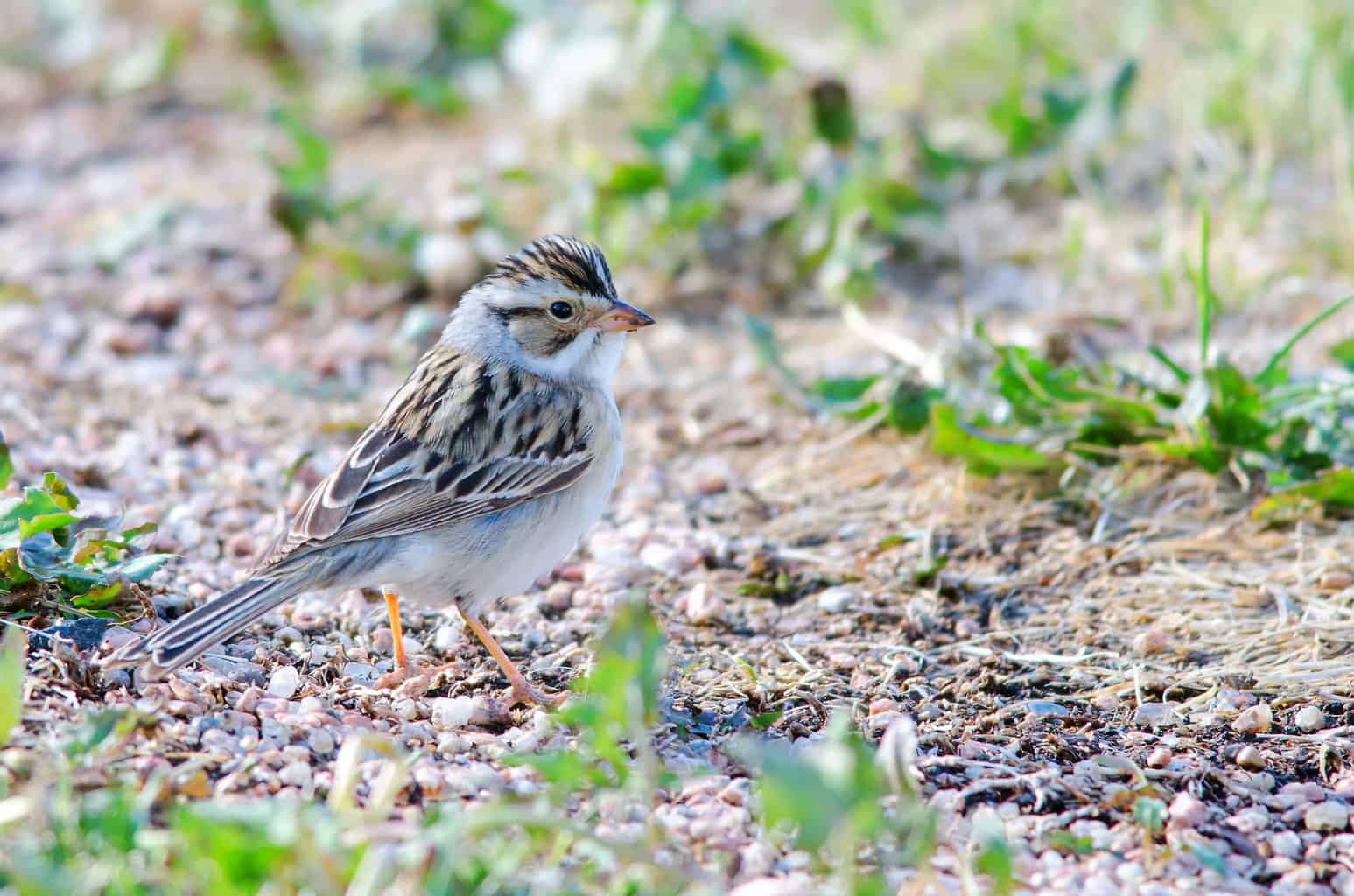
- Scientific name: Spizella pallida
- Length: 5.1 to 6.0 in
- Weight: 0.35 to 0.42 oz
- Wingspan: 7.1 to 7.8 in
The Clay-colored Sparrow is another popular bird that you can specifically find in the state of North Dakota.
The bird is fairly small with a tiny bill and a thin body. The bird’s notched tail is decently long for its size. The crown of the bird has some fine streaks with a light-brown stripe across the bird’s face and cheeks.
These birds are typically found among shrubs or on the near-shrub ground where they forage while blending with their background.
Short-Eared Owl

- Scientific Name: Asio flammeus
- Length: 13.4 to 16.9 in
- Weight: 7.3 to 16.8 oz
- Wingspan: 33.5 to 40.5 in
There are plenty of owl species in the state of North Dakota. However, the most common one in the state is the Short-eared Owl.
This one is quite a charismatic bird and you can easily spot them because, unlike most other owls, the Short-eared Owl is a diurnal bird.
The bird has small ear tufts, which is the reason behind the name. They have a rounded head along with a yellow facial disk and white lines that surround the edges
Red-Tailed Hawk

- Scientific Name: Buteo jamaicensis
- Length: 17.7 to 22.1 in
- Weight: 24.3 to 45.9 oz
- Wingspan: 44.9 to 52.4 in
In addition to the short-eared owl, the state also has another popular raptor. In fact, the Red-tailed Hawk is the largest bird of prey in all of North Dakota and surrounding states.
You’ll most likely find the bird soaring up high above the vast countryside and agricultural land. When not flying they like to perch on fence posts and high telephone wires.
The bird has an intimidating look with reddish-brown plumage that exists in shades of white, black, and brown. Red-tailed Hawks feast on small mammals and reptiles, such as mice, squirrels, frogs, and snakes.
Wrap Up
This marks the end of today’s article about the magnificent variety of birds in North Dakota. As you can see, the Peace Garden State has no shortage when it comes to types of birds, whether it’s by color, behavior, habitat, and more!
However, you should keep in mind that this article is just a quick snap of the most impressive and colorful birds that you’re going to spot in the state.
There are tons of other exciting and beautiful birds that you can come across while in North Dakota!

